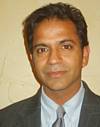|
Former President Bill Clinton's Heart Attack Serves as a Wake-up Call for those who choose to ignore the warning signs of a heart attack until it's too late. Being aware of the risk factors, following good lifestyle habits and early diagnosis can certainly put you ahead of the proverbial “8” ball, says Dr
Chandra.
Former President Clinton’s seemingly unsuspected blockages in the arteries of his heart took him, as well as the nation by surprise. This clearly was a blessing in disguise for the former president. This discovery, and subsequent heart operation, designed to restore blood flow to the heart will reduce his risk of having a heart attack, as well as risk of death considerably.
Typically in 50% of people with undiagnosed heart disease, the first sign of blocked arteries is “Sudden Death” or massive heart attack. Therefore, it is fortuitous when blocked arteries are discovered prior to having a heart attack. With the current advances in screening and testing for heart disease, we expect marked reduction in this catastrophic event.
Former President Clinton, was fortunate enough to have some warning signs such as chest tightness and breathlessness. He should be commended in responding to those signs. However, lack of these symptoms does not imply adequate blood flow to the heart. Some people with severe blockages may never experience any symptoms at all.
Typical and proven risk factors for heart disease include a family predisposition to heart disease, diabetes, smoking, high cholesterol, high blood pressure, cocaine use, lack of exercise, poor dietary habits, obesity (people are considered obese when they are 20% over their ideal weight) and high stress lifestyle. There are more subtle risk factors which need to be specifically tested for at your doctors’ discretion. [Some emerging risk factors which have not been proven conclusively are the maladies of the modern society. This includes people living with chronic stress.]**
Although, a lot can be done should a heart attack occur, it is best treated with prevention. Close surveillance of blood pressure, cholesterol and weight, with lifestyle counseling should begin in the twenties. In patients with significant risk factors, assessment for possible blocked arteries can begin even as early as the thirties. Many cardiologists have encountered patients with heart disease who are in their twenties. However, at an average, most heart disease is discovered in the forties to sixties.
The process of plaque buildup in the arteries of the heart begins as early as the late teen years. This is usually a slow, insidious process. At this stage the diagnosis can be very difficult as it primarily involves the protective lining of the artery wall. These are usually discovered incidentally during autopsies in homicide or motor vehicle fatalities. Therefore, good lifestyle habits need to begin in the early childhood years.
Being aware of the risk factors for heart disease, and at least making a serious attempt to follow good lifestyle habits, can certainly put you ahead of the proverbial “8” ball. However, early diagnosis is still the key for most people. Today there are several modalities available for diagnosing heart disease. Most accurate is the
angiogram. This is commonly referred to as a “Cardiac Catheterization”. This is an invasive test which requires wires and conduit tubes to travel up to your heart. There are inherent risks associated with the test, therefore, they are only offered to people who are felt to be at very high risk. This is usually at the cardiologist’s discretion. More commonly, Stress Testing is utilized, which can be done with or without a nuclear dye injection. This test is felt to be an excellent low risk test for diagnosis of heart disease. Again, this has to be done at your doctor’s discretion as the results can be sometimes misleading. They have to be taken in the context of the whole person who is being evaluated. Nonetheless, it is a very valuable tool in a cardiologist’s tool box. Some of the newer modalities include high speed computed tomograms, commonly advertised as “calcium scoring” or “lifescan”. At present, their value is limited to a very low risk population, who more than likely do not merit any testing. There is some growing concern that these tests do expose patients to a significant amount of radiation. Therefore, these tests need careful consideration of your physician.
Appropriate use of any of the above tests along with sensible lifestyle habits can certainly combat heart disease very effectively. A common misconception is that once the blood flow to the heart is restored either by surgery or stents the battle is over. Not quite, .
restoration of blood flow is just a temporizing measure which gives your cardiologist time to implement more permanent changes to your physiology to avoid recurrence of blockages. This includes careful surveillance for recurring blockages as well as lifestyle changes and medications. Together, they can minimize the risk of heart attack or recurring blockages. Therefore, to really optimize the new lease on life that former president Clinton has received, he and his physicians will need to significantly alter his risk factors. The real work begins now!!
*Disclaimer:
The contents are meant for informative, educational purposes only. Formal recommendations can only be made by physicians involved in your care. Please check with your physician before acting on any part of this article.
|


